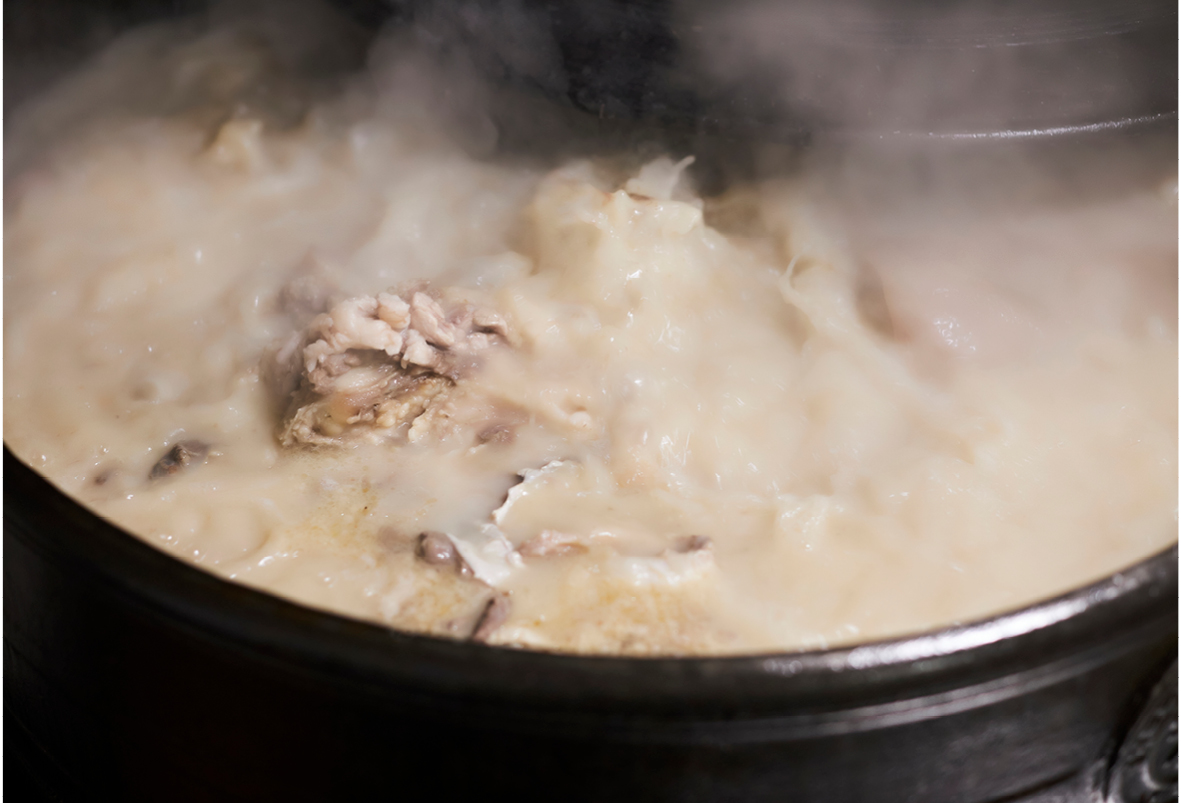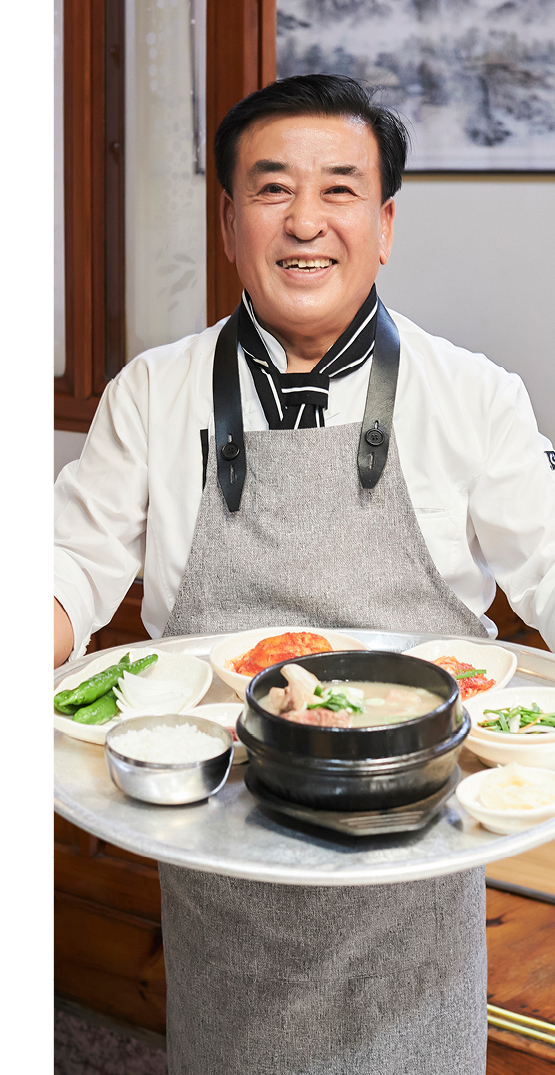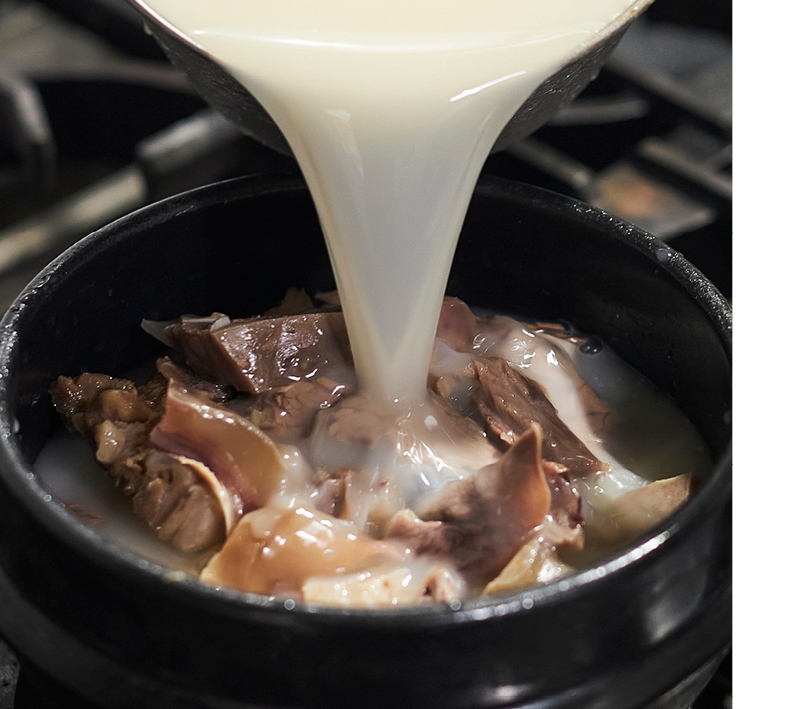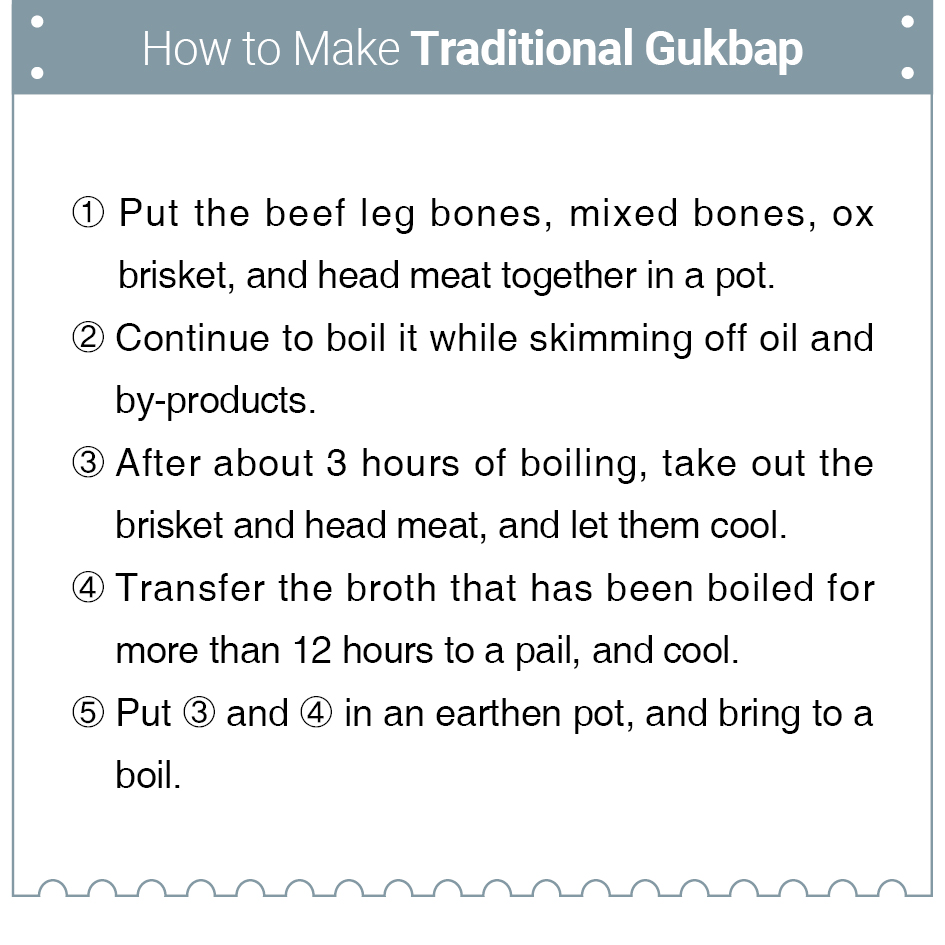한식 읽기 좋은 날
Vol 45. Gukbap, the Epitome of
The Memory of a Warm Spoonful of Gukbap
Korean Food and People
The history of gukbap is parallel to our modern and contemporary history.
At the time, when food was scarce, but people were kind, there was a bowl of gukbap, boasting of a rich and clean flavor, that was a typical dish on market days.
However, even now, when our eating habits have become more abundant, gukbap occupies a place in our diet as an indispensable food. It is a dish that is still favored as a meal to fill the stomachs of office workers, and as a hearty nourishing food for those in need of nutrition.
We met Kim Jongyeol(owner of Anilok), and heard about our unique sentiment for gukbap and his efforts to inherit it.
Article. Lee Jongcheol Photo. Park Chanhyuk
| Actually, just because gukbap(wootang: beef soup) is soupy and thick, it doesn’t mean that it’s rich. Genuine gukbap should have a clear and clean broth with a deep aftertaste. |


Q. What kind of changes did gukbap go through until it took on its current form? Looking at 100 years of a century, we are curious about the changes in gukbap and in gukbap restaurants.
Unlike today, during the Japanese colonial period, liberation, and before and after the Korean War, food was not abundant. In the case of Anseong, Gyeonggi-do, there were many soup stores that sold gukbap dishes made with various by-product meats from the cattle market when the market opened. At the time, stores sold not just gukbap, but a variety of dishes, such as galbi(ribs), seolleongtang(ox bone soup), baekban(meal with rice, soup and side dishes), and buchimgae(vegetable pancakes). Gukbap was called “wootang”(ox soup) because the ingredients available at the time were different. It was also made differently according to the customer’s preference.
Until the 1970s, when there were no refrigerators and heating cabinets, once the rice was cooked, it was spread flat on a wicker tray and stored in a cool place. When an order was placed, the rice was put in a bowl, and the broth was poured in and out several times to make it warm. Until then, pouring hot broth over the rice was common, and since the broth was absorbed into the grain of the rice, its taste improved. With the introduction of the heating cabinet, ttarogukbap(rice and soup served separately) emerged. I think customers prefer it, not because it tastes better, but because it's convenient, and they can see what kind of rice is used for the dish.
One more thing that's different from the early days was fuel. At first, wood fires were used, and then they were changed to briquettes. Now, most of them use gas. Since it has to be simmered continuously for more than half a day, wood fires and briquettes pale in comparison.
 Q. There seems to be plenty of concerns about the possibility of traditional dishes, such as gukbap, being on the decline as people's tastes and preferences have become Westernized lately.
Q. There seems to be plenty of concerns about the possibility of traditional dishes, such as gukbap, being on the decline as people's tastes and preferences have become Westernized lately.
There are people with such concerns because the main customer base is the older generation. However, I don't agree with them. I think our taste buds have a record of the food we ate in the past and have nostalgia for such taste, just like our DNA. Gukbap is still one of the most popular meals for office workers, and, with Anilok alone, many young people yearn for the food.
On the other hand, considering that the aging index of our society is gradually increasing, it seems unlikely that traditional food would be on the decline. Even if time passes, I think gukbap will continue its history as a permanent steady seller.
Q. Why do you think gukbap has been loved for a long time, and what is its charm?
It is the unique sentiment of the dish – ampleness, warmth, and familiarity. My grandmother said, “A restaurant is where hungry people come, and they come to fill their stomachs so let them go after they eat heartily.” I think this is a common motto that can be applied to other gukbap restaurants. If it is a gukbap dish full of compassion made with good ingredients and with the cook’s sincerity, it will definitely appeal to people in the future.
Q. Could you give us any tips or advice on how to make delicious gukbap or gomtang at home?
There is no special advice or secret to making gukbap better. All I can say is, “Eat as it is.” Gukbap is a fast food when eating it, but it is a slow food when making it. To make a bowl of gukbap, good ingredients are carefully selected and bought, boiled for more than 12 hours from the early morning. Impurities are skimmed during those hours. And then it is cooled after being moved to a pail, and boiled again for 12 hours after the original pot is cleaned. The subsidiary ingredients are cooked for about 3 hours, and then cooled and sliced thinly. When this process is repeated, it means that the fire on the stove never goes out. The broth made after the process is clear and light, but, at the same time, it has a very rich aftertaste. To enjoy the genuine taste of gukbap, I recommend you to eat it as it is.
Q. Please tell us how many times it is recommended to boil the beef bone, which is the basis of gukbap, and the most reasonable way to balance its nutrition and taste.
Based on the data I looked up before, there was a study that analyzed the physicochemical characteristics, palatability, and organizational characteristics of a dish by simmering hanwoo(Korean beef) leg bones several times.(<The effect on the physicochemical, organoleptic, and nutritional properties of seolleongtang according to cattle bone breeds> Rural Development Administration, Livestock Technology Research Institute, 2000) According to this study, simmering it up to three times is the best in terms of taste and nutritional value. The broth that has been simmered for too long will be less palatable, and turbidity and viscosity will decrease. So, when boiling beef bone at home, it is recommended to simmer it for 6 hours at a time, up to 3 times. You can boil the beef bones on chilly days, like nowadays because the broth can be used in a variety of dishes, not just for guk or tang(types of soup), so it would be a hearty, nourishing food.
Q. What conditions must be met for traditional Korean food, including gukbap, to be sustainable?
 This is something that all Korean restaurants should think about together. In addition to the topics that have been discussed in the past, such as the changes in the Korean food market and the generations, the non-contact trend, including take away and delivery services due to COVID-19, has also been considered lately. Due to this impact, meal kit and retort markets are being significantly expanded. Recently, new attempts and various trends have appeared in Korean cuisine, but, honestly, there are some concerns. If you only follow trends, competition will only intensify, and the Korean food market may fall into a crisis by limiting people's palates. For Korean food to continue its legacy, the restaurants that serve typical Korean food, such as jjigae(stew) and baekban(meal with rice, soup and side dishes), the gukbap restaurants that stubbornly maintain their own color, and the ones with trendy and novelty offerings must coexist in a variety of ways. Of course, a specialty restaurant that preserves the value of Korean food should be the foundation. I think when the physical strength of Korean food is built up, more people will like Korean food, and continue to seek it.
This is something that all Korean restaurants should think about together. In addition to the topics that have been discussed in the past, such as the changes in the Korean food market and the generations, the non-contact trend, including take away and delivery services due to COVID-19, has also been considered lately. Due to this impact, meal kit and retort markets are being significantly expanded. Recently, new attempts and various trends have appeared in Korean cuisine, but, honestly, there are some concerns. If you only follow trends, competition will only intensify, and the Korean food market may fall into a crisis by limiting people's palates. For Korean food to continue its legacy, the restaurants that serve typical Korean food, such as jjigae(stew) and baekban(meal with rice, soup and side dishes), the gukbap restaurants that stubbornly maintain their own color, and the ones with trendy and novelty offerings must coexist in a variety of ways. Of course, a specialty restaurant that preserves the value of Korean food should be the foundation. I think when the physical strength of Korean food is built up, more people will like Korean food, and continue to seek it.












